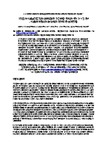GRAVEL BEACH CROSS- AND ALONGSHORE RESPONSE TO AN EXTREME EVENT: BEACH LENGTH AND HEADLAND PROXIMITY CONTROLS
| dc.contributor.author | McCarroll, Jak | |
| dc.contributor.author | Masselink, Gerd | |
| dc.contributor.author | WIGGINS, M | |
| dc.contributor.author | Scott, Tim | |
| dc.contributor.author | BILLSON, O | |
| dc.contributor.author | Conley, Daniel | |
| dc.date.accessioned | 2019-07-09T10:50:45Z | |
| dc.date.available | 2019-07-09T10:50:45Z | |
| dc.date.issued | 2019-05 | |
| dc.identifier.uri | http://hdl.handle.net/10026.1/14615 | |
| dc.description.abstract |
Gravel beach morphologic change is a function of combined cross- and alongshore transport. At present, numerical methods deal with these processes separately. We present observations from Start Bay, UK, of extreme storm response and recovery, across five gravel subembayments (lengths 250 m to 5 km). An easterly storm sequence in Feb-Mar 2018 forced massive alongshore transport (rotation and headland bypassing) and cross-shore transport including erosion of the barrier, destruction of barrier-crest roads, and distribution of material offshore. We demonstrate that profile response is a function of embayment length and headland proximity, such that: (i) pocket embayments (~250 m) experience a uniform response; (ii) short embayments (~500 m) rotate around a pivot point; (iii) longer bays (>1 km), exhibit a weak cut-fill response near the mid-point; and (v) long beaches (>5 km) show a strong cross-shore response, with rotation near the headlands. This study aids development of fully-coupled gravel transport models. | |
| dc.format.extent | 2735-2745 | |
| dc.language.iso | en | |
| dc.publisher | WORLD SCIENTIFIC | |
| dc.title | GRAVEL BEACH CROSS- AND ALONGSHORE RESPONSE TO AN EXTREME EVENT: BEACH LENGTH AND HEADLAND PROXIMITY CONTROLS | |
| dc.type | conference | |
| plymouth.conference-name | International Conference on Coastal Sediments 2019 | |
| plymouth.publication-status | Published | |
| plymouth.journal | Coastal Sediments 2019 | |
| dc.identifier.doi | 10.1142/9789811204487_0234 | |
| plymouth.organisational-group | /Plymouth | |
| plymouth.organisational-group | /Plymouth/Faculty of Science and Engineering | |
| plymouth.organisational-group | /Plymouth/Faculty of Science and Engineering/School of Biological and Marine Sciences | |
| plymouth.organisational-group | /Plymouth/PRIMaRE Publications | |
| plymouth.organisational-group | /Plymouth/REF 2021 Researchers by UoA | |
| plymouth.organisational-group | /Plymouth/REF 2021 Researchers by UoA/UoA07 Earth Systems and Environmental Sciences | |
| plymouth.organisational-group | /Plymouth/Research Groups | |
| plymouth.organisational-group | /Plymouth/Research Groups/Marine Institute | |
| plymouth.organisational-group | /Plymouth/Users by role | |
| plymouth.organisational-group | /Plymouth/Users by role/Academics | |
| plymouth.organisational-group | /Plymouth/Users by role/Researchers in ResearchFish submission | |
| dcterms.dateAccepted | 2019-01-01 | |
| dc.rights.embargodate | 2023-7-19 | |
| dc.rights.embargoperiod | Not known | |
| rioxxterms.versionofrecord | 10.1142/9789811204487_0234 | |
| rioxxterms.licenseref.uri | http://www.rioxx.net/licenses/all-rights-reserved | |
| rioxxterms.type | Conference Paper/Proceeding/Abstract | |
| plymouth.funder | Physical and biological dynamic coastal processes and their role in coastal recovery (BLUE-coast)::NERC |


